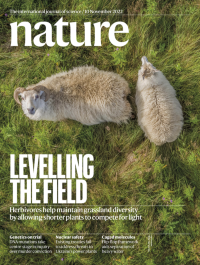Volume 611
-
No. 7937 24 November 2022
Pump, rest, leak, repeatThe cover illustration shows vacuolar-type adenosine triphosphatases (V-ATPases, large blue structures) on a synaptic vesicle from a nerve cell in the mammalian brain. V-ATPases pump protons across cellular membranes, and in neurons this process is essential for loading neurotransmitters into synaptic vesicles. In this week’s issue, Dimitrios Stamou and his colleagues shed light on V-ATPase dynamics in single native synaptic vesicles. By imaging proton-pumping at the single-molecule level, the researchers were able to see that V-ATPases do not pump continuously but instead switch between three distinct modes: proton-pumping, inactive and proton-leaking. The team suggests that this could indicate a broader biological role for ultraslow mode-switching in protein regulation.
-
No. 7936 17 November 2022
Plugging the gapA lack of data on economic outcomes hinders development and evaluation of public policy in many parts of the world. In this week’s issue, Marshall Burke and his colleagues show how satellite imagery can be combined with machine learning to help plug this data gap. The researchers focused on the expansion of the electricity grid in Uganda. Using satellite imagery and local survey data on household wealth, the team trained a neural network to predict the economic outcomes for households throughout the country, including those that had recently been connected to the electricity grid. The results affirmed a positive causal link between electricity access and asset wealth in rural villages.
Nature Outlook
-
No. 7935 10 November 2022
Levelling the fieldAdding nutrients to soil or removing grazing herbivores such as sheep reduces plant diversity in grasslands. In this week’s issue, Anu Eskelinen and her colleagues show that a key factor driving this reduction is competition among plant species for light. Working on German grassland, the researchers used lamps placed close to ground level to counteract the shading effect from vigorous growth in taller plants. They found that although the addition of nutrients and the removal of herbivores promoted the growth of tall plants, reduced light levels and decreased diversity, the introduction of light close to the ground could offset this and helped to maintain diversity. These results suggest that both native and domesticated grazing animals could help to protect biodiversity in grasslands.
-
No. 7934 3 November 2022
Heat stressThe cover shows a splendid treefrog (Cruziohyla calcarifer) in Costa Rica. The biological processes of ectotherms, such as amphibians, insects and fish, are directly affected by temperature, which means even small rises can cause significant problems. In this week’s issue, Johannes Overgaard and his colleagues examine the potential effects of climate change on these creatures. The researchers find that in the range of temperatures deemed as broadly survivable, for every rise in temperature of 1 °C, the rate of biological processes maintaining growth, homeostasis and ageing increases by 7%. But for every 1 °C rise in the range of temperatures deemed potentially dangerous, the rate of heat failure, which leads to death, increases by more than 100%. The team notes that this sensitivity to extreme heat in ectotherms is expected to lead to greater mortality as the frequency and intensity of heatwaves increases.




